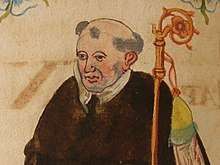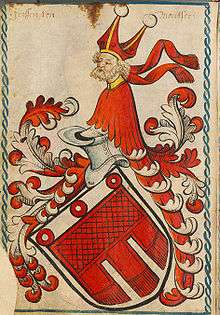Wilhelm von Montfort
Wilhelm I Count of Montfort († 11 October 1301) was prince-abbot of Saint Gall from 1281 until 1301.

Political Situation at the End of the 13th Century
By the end of the abbacy of Berchtold von Falkenstein (died 10 June 1272), Count Rudolf of Habsburg began to restrict the influence the abbey had on the region of Thurgau. An election for the successor of Berchtold ended in conflicting results, giving Rudolf the opportunity to seize more influence and become more involved in matters of the abbey (he was crowned king in 1273). Rudolf sided with Ulrich von Güttingen, who was elected abbot by the citizens of the city of St. Gallen. The convent, however, had chosen Heinrich von Wartenberg, whom the citizenry rejected on the grounds of being from the same family as Berchtold. The Gotteshausleute (inhabitants of the area of influence of the Abbey), especially the city of St. Gallen, which at the time had not yet gained independence from the Abbey, accepted Rudolf as protector, which was confirmed to them in a Handfeste. However, Rudolf appointed Ulrich von Ramschwag as Vogt over the princely abbey. Additionally, Ulrich was a bad economist who amassed a large amount of debt for the city, in large parts due to his warring efforts against Heinrich von Wartenberg. Ulrich also fought against Heinrich's successor, Rumo von Ramstein. When Ulrich died, everybody recognised Rumo as the only legitimate abbot. The Abbey's economic standing did not improve, however, as Rumo had to sell many treasures to pay the amassed debt and was generally seen as inept. He abdicated in 1281 when he could not handle the situation any longer.
Tenure

Wilhelm's election signalled a systemic change for Saint Gall. he was elected abbot from the dynasty of the counts of Montfort, which was hostile towards the abbey during Berchtold's abbacy and sided with Ulrich during the time of double rule. While the spreading influence of the Montforts from the Rheintal to the Argengau had been a point of contention between the house and the convent, the electorate now sought to use the name of the counts for their own benefit. Ulrich had influential secular brothers who boosted his election, among which were Rudolf I von Montfort, Ulrich I von Montfort as well as the later bishop of Chur, Friedrich von Montfort. After the election, Wilhelm endeavoured to restore the Abbey's former glory. Those ambitions were stopped by king Rudolf who, after dealing with his strong will, grew more hostile towards Wilhelm. Wilhelm was forced to interrupt his first visit at the royal court in Augsburg abrubtly in December 1282 to avoid further impositions from the king. Inhabitants of the abbey were so unhappy with Wilhelm's savings policy and his orders that every monk should be ordained priest, that they lodged a complaint at the royal court. Their accusations were backed by the court and in 1287, Rudolf constricted Saint Gall's access to secular goods and used his influence on a papal legate to impose an anathema on Wilhelm.
The king had built the castle Schwarzenbach as a stronghold against the city of Wil, an important trading centre of the Gotteshaus (area under rule of the Abbey). A fierce fight erupted there in August and September 1287. An agreement of atonement was settled outside of Wil on the 6 September 1287. However, when Wilhelm visited the king to finalise the peace, the agreement fell through and Rudolf forced Wilhelm to make further concessions towards the king's sons Albert I and Rudolf II. Spurred by this, Wilhelm continued the fight, assisted by his brother, Bishop Friedrich. The king placed more interest into Ulrich von Ramschwag. When the ruling that Wilhelm was to be excommunicated was finalised, the king, followed by his sons Albert and Rudolf, appointed the abbot of Kempten, Konrad von Gundelfingen to be anti-abbot. Supporters of Wilhelm were threatened to receive the imperial ban if they continued their support.
Count Rudolf II stayed behind to fight Wilhelm, who now had to endure a time of defeat and persecution. His castles, among which was castle Alt-Toggenburg, fell into enemy hands. One after the other, his refuges were lost or became unusable. Bishop Friedrich was captured in a battle and died in 1290 when he attempted to escape from Werdenberg castle, which was controlled by Hugo von Montfort, who was on the king's side. Only Rudolf's death on the 15 July 1291 changed the power relations. On the 25 July that same year, the citizens of the city of St. Gall, who had remained loyal to Wilhelm, reinstated him as the only legitimate abbot. He thanked the citizenry by formalising their rights on the 31 July 1291 in a comprehensive treaty.
%2C_Heinrich_III._(%E2%80%A0_1307%2C_Mitte)_und_Wilhelm_I._von_Montfort_(%E2%80%A0_1301%2C_rechts).jpg)
Konrad von Gundelfingen had to leave his post. He tried to re-establish himself as abbot through martial means, but relented when Wilhelm paid him 100 Mark. Wilhelm, along with other enemies of the late king, joined an alliance against count Albert which was being assembled by bishop Rudolf von Konstanz. Subsequently, war erupted again in the Gotteshaus. Albert was largely victorious, but Ulrich von Ramschwag's sons – Ulrich himself had been driven out of the city when Wilhelm returned – suffered a major defeat outside the city of St. Gall on the 15 February 1292. Following these events, the conflict was seemingly de-escalating, but never ceased entirely. In 1296, Wilhelm travelled to Austria to negotiate a peace treaty but had to leave without satisfying the wishes and hopes of everybody in St. Gall.
When a feud broke out between Albert and King Adolf of Germany, who was Rudolf I's successor, Wilhelm joined forces with the new king, as he had shown himself to be beneficial towards St. Gall. After being granted assurances in the treaty of Schletstatt of 1 September 1297, the abbot consulted with King Adolf for the first time in the vicinity of Frankfurt to support him in his campaign against Albert I. In the summer of 1298, Wilhelm was the only clerical ruler ("Pfaffenfürst") in Adolf's camp. On the 2 July at the battle of Göllheim, Wilhelm was one of the fugitives from the battlefield. Defeated and faced with economic difficulties due to the military expenditures and losses, he returned to the abbey. Moreover, the old enemy, Albert I, was now king. Only in 1301 could the questions raised about Schwarzenbach since 1292 be reconciled with the new king. According to the contents of the contract, the implementation of which would be delayed and never completely finalised, the castle and the city of Schwarzenbach should have been broken broken up and the city of Wil would have been completely restored. However, Wilhelm had already fallen ill when Bishop Heinrich von Konstanz could report about a settlement. He died on 11 October, five days before the completion of the peace treaty.
Reading list
- Meyer von Knonau (1898), "Wilhelm von Montfort", Allgemeine Deutsche Biographie (ADB) (in German), 43, Leipzig: Duncker & Humblot, pp. 218– (ADB). Band 43, Duncker & Humblot, Leipzig 1898, S. 218.
- Duft, Johannes: Die Abtei St. Gallen, St. Gallen 1986.
External links
- Montfort, Wilhelm von in German, French and Italian in the online Historical Dictionary of Switzerland.
- Abbot Wilhelm von Montfort in the city lexicon of Wil